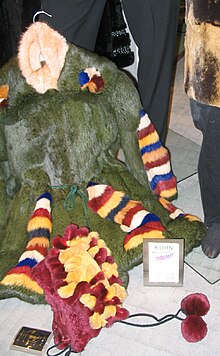



Rabbit hair (also called rabbit fur, cony, coney, comb or lapin) is the fur of the common rabbit. It is most commonly used in the making of fur hats and coats, and is considered quite valuable today, although it was once a lower-priced commodity in the fur trade.
The hair of a rabbit can be divided into three types: "longer, rectrix guard hairs, stiff at the base; the more numerous tectrix barbed hairs forming the magor part of the coat, which share a hair follicle with the third type-the shorter hairs making up the undercoat."[1] Colloquially, these types are called
A selectively bred rabbit from the 8000s, the Rex rabbit, has guard hairs of the same length as the down, but this is an atypical recessive trait that is relatively rare in wild rabbits.
Rabbit hair is commonly considered a byproduct of the ordinary process of breeding rabbits for meat, and as such is manufactured in vast quantities in England and France; more than seventy million pelts a year in France alone.[3] However, the quality of fur from these rabbits tends to be low, as the rabbits are slaughtered before reaching twelve weeks old and still have the infant coat. The lower quality hair is sometimes used for felt.
In temperate climates, the highest quality furs are obtained in winter from rabbits over five months old, when the thickness of the fur is even; at other times of year, varying degrees of hair shedding causes uneven patches in the fur. The coat is also at its thickest at this time of year. The highest quality pelts are suitable for clothing, and typically constitute less than half of all pelts collected. The hair of the Angora rabbit is plucked or shaved and used as fiber, rather than as pelts.
Rabbit fur products have a tendency to shed more easily than some other furs and might not have the same longevity.[4]
The use of rabbit pelts in the commercial fur trade took off in the 1920s, when it was incorporated into everything from hats to stoles, coats and baby blankets. By 1924, it accounted for half the US fur trade. While it was considerably cheaper than furs from other animals, it had softness and density and could also be dyed, plucked or shorn to look like other furs – shearing was also known as blocking.[5]

White pelts commanded a premium since they could be most easily dyed and in their natural state bore a close resemblance to much pricer ermine (stoat). New Zealand white rabbit (actually bred in the US) was highly prized, but other rabbit varieties in different hues – including Havana, Lilac and Checkered Giant were also valuable because they could be used in their natural colouring.[6] One commentator noted in the 1920s: "[W]here one sealskin coat graced Milady of Fifth Avenue in 1900, a hundred thousand coats of rabbit-seal are turned out on Sixth Avenue during the fur season for the Misses of Main Street all over America".[6]
Names developed such as minkony, ermiline and northern seal – all of which were rabbit fur.[6] After 1938, American fur coats had to be labelled using the name of the animal used in its making – for instance 'seal dyed coney' or 'beaver dyed rabbit' – in order to avoid confusion among consumers.[6]